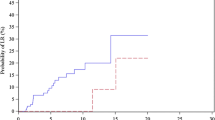Background:
The treatment of ductal carcinoma in situ of the breast (DCIS) has changed dramatically during the last decade.
Material and Methods:
In a review article, prospective randomized and retrospective studies of different treatment options of DCIS are evaluated to define the new role of radiotherapy.
Results:
Until a few years ago, total mastectomy was the standard treatment of DCIS achieving a 95-98% cure rate. Three randomized studies show that adjuvant radiotherapy following local excision significantly reduces the rate of invasive and noninvasive recurrences by 40-60%, thus making breast conservation possible. Retrospective studies evaluated prognostic factors (tumor size; age; margin width, presence of necrosis; grading) in order to define subgroups of patients whom adjuvant radiotherapy can be safely spared. Adequately excised tumors with favorable grading and not associated with necrosis are potential candidates. Further evaluation in prospective randomized studies is, however, required.
Conclusions:
Radiotherapy is an essential part of breast-conserving treatment of DCIS to achieve sufficient local control.
Hintergrund:
Die Behandlung des duktalen Carcinoma in situ (DCIS) hat sich im letzten Jahrzehnt deutlich geändert.
Material und Methodik:
In einem Übersichtsartikel werden prospektive und retrospektive Studien ausgewertet, um die Rolle der Strahlentherapie neu zu definieren.
Ergebnisse:
Bis vor wenigen Jahren war die Mastektomie die Standardbehandlung des DCIS mit Heilungsraten von 95-98%. Drei randomisierte Studien zeigen, dass eine adjuvante Radiotherapie nach Tumorexzision die Rate an invasiven und nichtinvasiven Rezidiven signifikant um 40-60% senkt. Auf diese Weise ist eine sichere Brusterhaltung möglich. Retrospektive Untersuchungen bewerteten prognostische Faktoren (Tumorgröße; Alter; Weite des Resektionsrandes; Nekrosen; Differenzierungsgrad), um Subgruppen zu definieren, bei denen auf eine adjuvante Bestrahlung ohne Erhöhung der lokalen Rezidivrate verzichtet werden kann. Potentielle Kandidaten sind adäquat exzidierte Tumoren mit einem günstigen Differenzierungsgrad, die nicht mit Nekrosen assoziiert sind. Allerdings müssen diese Ansatzpunkte noch in prospektiv-randomisierten Studien überprüft werden.
Schlussfolgerungen:
Die Strahlentherapie ist ein wichtiger Bestandteil der brusterhaltenden Therapie des DCIS, um eine adäquate lokale Kontrolle zu erreichen.
Similar content being viewed by others
Author information
Authors and Affiliations
Corresponding author
Additional information
This paper is dedicated to Professor Rolf Sauer, MD, chair of the Department of Radiation Oncology, University of Erlangen, on the occasion of his 65th birthday.
Rights and permissions
About this article
Cite this article
Fietkau, R. Ductal Carcinoma in Situ of the Breast. Strahlenther Onkol 180, 682–689 (2004). https://doi.org/10.1007/s00066-004-9192-1
Issue Date:
DOI: https://doi.org/10.1007/s00066-004-9192-1



